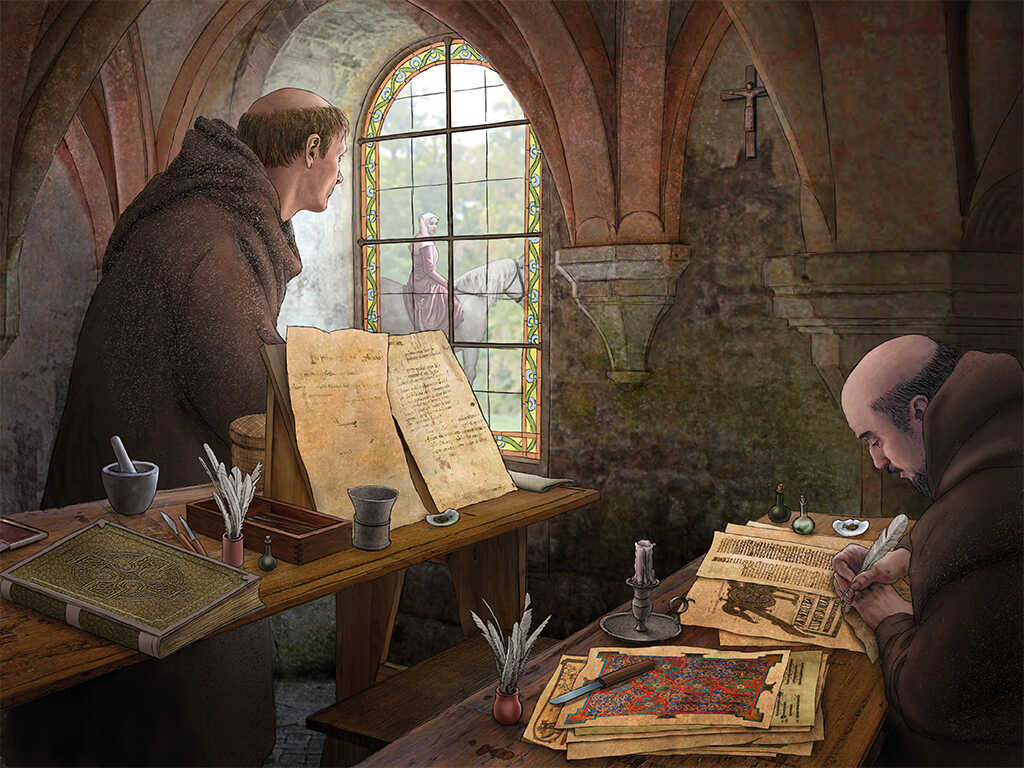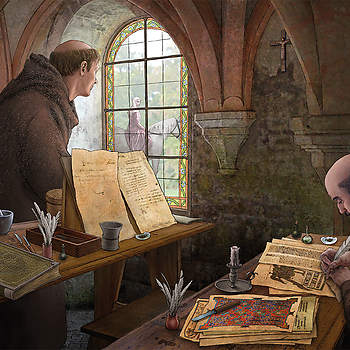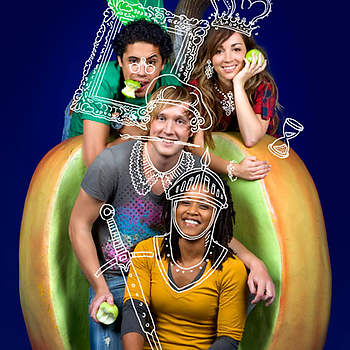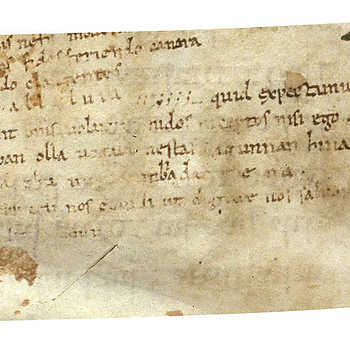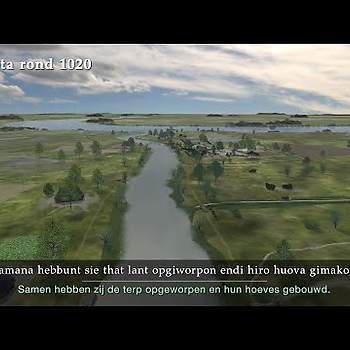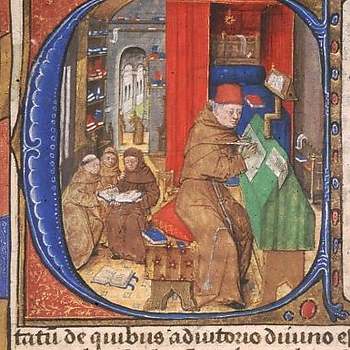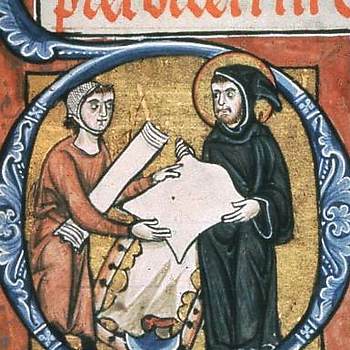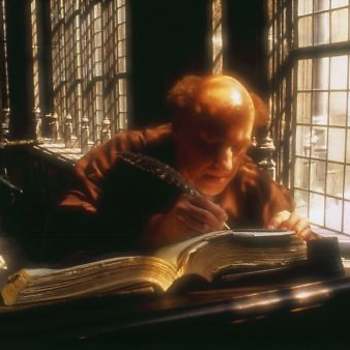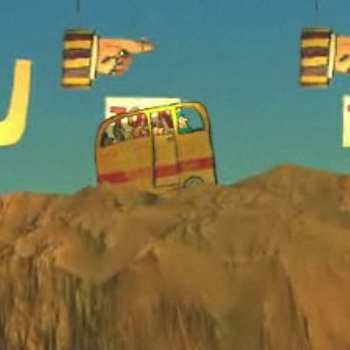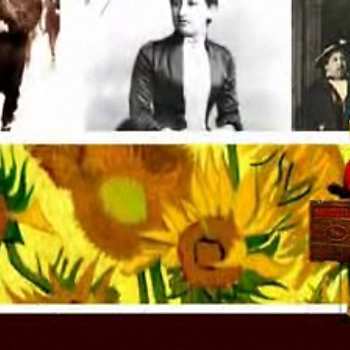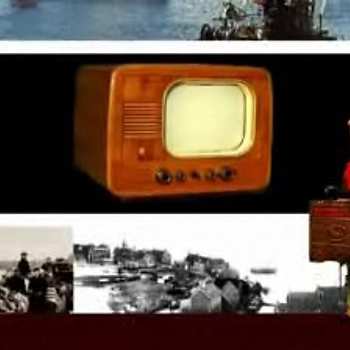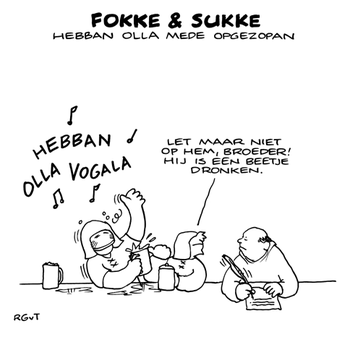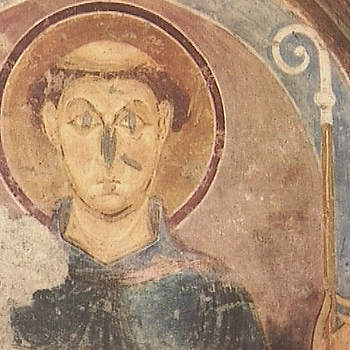-
Een klooster in de Middeleeuwen
In de Middeleeuwen was bijna iedereen in Nederland christelijk.
Veel mannen en vrouwen gingen het klooster in: ze werden monnik of
non. Binnen de kloostermuren konden ze in alle rust aan God denken
en bidden. Ook schreven ze in hun schrijfzaal of
scriptorium veel boeken over.
-
Het scriptorium
De meeste kloosters hadden een zaal waar boeken overgeschreven
konden worden: het scriptorium. Daar stonden speciale
schrijftafels. Ook waren er alle spullen die nodig waren om te
kunnen schrijven, zoals perkament, inkt en ganzenveren.
Boeken waren in de Middeleeuwen erg zeldzaam. Er waren nog geen
boekwinkels. Als de monniken graag een bepaald boek wilden hebben,
probeerden ze dat van de monniken uit een ander klooster te
lenen.
Zodra ze het exemplaar dat ze zochten gevonden hadden, schreven
ze het in hun scriptorium over. Vervolgens konden ze het originele
boek weer teruggeven. Zo verspreidden boeken zich langzaam over het
land en zelfs over heel Europa.
De taal waarin de monniken lazen en schreven, was Latijn. Dat
was de taal van de kerk en van de geleerden. Nederlands was tot
ongeveer 1170 alleen een spreektaal, geen schrijftaal. Het is
daarom extra bijzonder dat er in zo'n oud kloosterboek opeens een
regeltje Nederlands opduikt.

-
Een liefdesliedje
Gerulf is juist op weg naar zijn schrijftafel als hij door het kloostervenster een jonkvrouw langs ziet rijden. Even kijkt ze hem recht in de ogen. Meteen schieten Gerulf de woorden van een liefdesliedje te binnen. Het liedje dat zijn meisje ooit voor hem zong, thuis in het verre Vlaanderen: Hebban olla vogala…
Of hij Gerulf heette, en of het zo gegaan is, weten we niet. Wel was er rond het jaar 1100 in een Engels klooster een monnik die een regel opschreef uit een liefdesliedje dat hij nog kende uit zijn jeugd in Vlaanderen. Hebban olla vogala nestas hagunnan hinase hic anda thu, wat unbidan we nu? Oftewel: 'Alle vogels zijn al met nestjes begonnen, behalve ik en jij; waar wachten we nog op?' Het is het eerste Nederlandse liefdesliedje dat we kennen, en bovendien een van de oudste opgeschreven zinnetjes in onze taal, bijna duizend jaar oud. De Nederlandse taal is zelfs nóg ouder, maar in die tijd was het alleen een spreektaal. De schrijftaal was Latijn, de taal van de kerk en de geleerden. Geschreven Nederlandse woorden duiken maar heel soms op. Pas vanaf 1170 wordt Nederlands ook een schrijftaal.
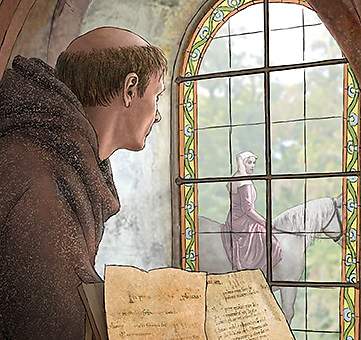
-
Monnikenwerk
Tegenwoordig worden boeken gedrukt. Van elk boek bestaan dus
honderden of duizenden exemplaren die er allemaal precies hetzelfde
uitzien.
Voor 1450 bestond de boekdrukkunst nog niet. Boeken werden stuk
voor stuk met de hand overgeschreven. Wat een monnikenwerk!
Boeken werden vooral in kloosters geschreven. Monniken
kopieerden een boek letter voor letter. Over een gewoon boek deden
ze al gauw een paar maanden en het overschrijven van een dik boek
kon zelfs meer dan een jaar in beslag nemen.
Deze monnik is trouwens niet bezig met schrijven, maar met het
in kleur schilderen van tekeningen en versieringen. Dat gebeurt op
bladzijden die door een andere monnik op de goede plekken al met
zwarte letters volgeschreven zijn.
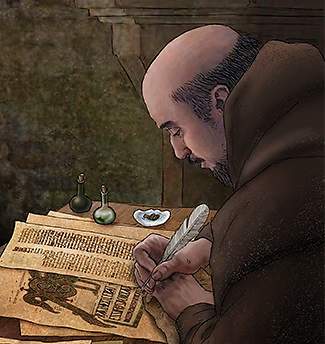
-
Een romantische pennenproef
In 1932 werd op de laatste bladzijde van een oud Engels
kloosterboek een Nederlands zinnetje ontdekt. Het staat op een
bladzij vol Middeleeuwse pennenproeven: woorden en zinnetjes die de
monniken opschreven om te testen of hun pen na het scherp maken
weer goed schreef.
Bovenaan de bladzij staat probatio penne si bona sit.
Dat is Latijn voor 'Proberen of de pen goed is'.
Verder naar onder staat het oude Nederlandse zinnetje. Er staat
(soms erg moeilijk leesbaar): Hebban olla vogala nestas
hagunnan hinase hic anda thu, wat unbidan we nu. Letterlijk
vertaald: 'Hebben alle vogels nesten begonnen behalve ik en jij,
wat wachten we nu?'
Waarschijnlijk is Hebban olla vogala... als pennenproef
opgeschreven door een monnik die in Vlaanderen is geboren en rond
1066 naar Engeland is gereisd. Daar is hij in het klooster terecht
gekomen. Dankzij hem kennen we een Nederlands liefdesliedje van
1000 jaar oud.
Hoewel je sommige woorden nog wel kunt herkennen, merk je aan
het zinnetje ook dat de Nederlandse taal in 1000 jaar sterk
veranderd is. Onze taal verandert trouwens nog elke dag...
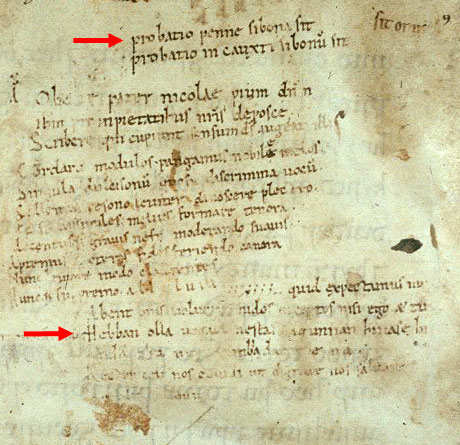
-
Perkament
Tegenwoordig schrijven we meestal op papier. Maar middeleeuwse
boeken zijn bijna allemaal op perkament geschreven. Perkament is
speciaal bewerkte dierenhuid van een kalf, geit of schaap. Voor een
dik boek als de bijbel had je wel 150 schapenvellen nodig.
Perkament was dan ook heel duur.
Hoe maak je perkament?
- Laat eerst de huid van een kalf, geit of schaap een paar dagen
in stromend water liggen, zodat die schoon en soepel wordt.
- Dompel daarna het vel twee weken in een mengsel van kalk en
water. De vleesresten aan de binnenkant en de haartjes aan de
buitenkant worden daardoor helemaal zacht en laten makkelijk
los.
- Span vervolgens de huid strak op een houten raamwerk, zodat die
goed en zonder rimpels kan drogen. Schraap met een scherp
bijlvormig mes de allerlaatste haar- en vleesrestjes eraf. Pas op
dat je er niet doorheen steekt!
- Wrijf tot slot met een stuk puimsteen of krijt over het vel
zodat het helemaal glad en goed beschrijfbaar wordt.
De hele klus duurt in totaal zo'n zes weken, en moet voor elk
vel weer herhaald worden. Je begrijpt dus wel: perkamentmaken is
een tijdrovend en kostbaar werkje.
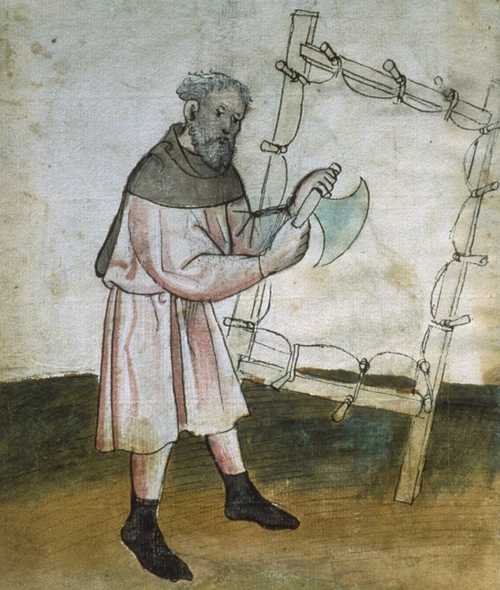
-
Zelf inkt en verf maken
Monniken maakten in het scriptorium hun eigen inkt en verf om
mooie boeken te kunnen maken. Inkt werd gemaakt door dingen uit de
natuur fijn te stampen in een vijzel en daarna met een dunne
kleefstof te mengen. Van walnoten maakte je bruine, van roet zwarte
en van schildluizen rode inkt.
Het maken van verf voor de mooie versieringen gaat eigenlijk net
zo.
- Je begint met het vinden en fijnstampen van mooie kleurstoffen.
Van de kostbare Lazuli-steen krijg je prachtig blauw. Met koper en
azijn kan je groen maken, en bladgoud maak je door een gouden munt
net zo lang plat te stampen tot het flinterdun goudpapier geworden
is. (Maar jij kunt voor al deze kleuren beter gewoon stoepkrijt
gebruiken).
- Stamp elke kleur tot fijn poeder en doe ze in aparte
potjes.
- Neem een ei, splits dooier en eiwit en doe ze in twee
verschillende potjes.
- Meng een beetje eigeel met een van de kleurpoeders tot je een
dikke vloeistof krijgt.
- Gebruik de verf om een mooi schilderijtje of versierde
hoofdletter te maken.
- Als de verf goed droog is, kun je de kleuren extra laten
glanzen door er met een kwast een dun laagje eiwit op te
schilderen.
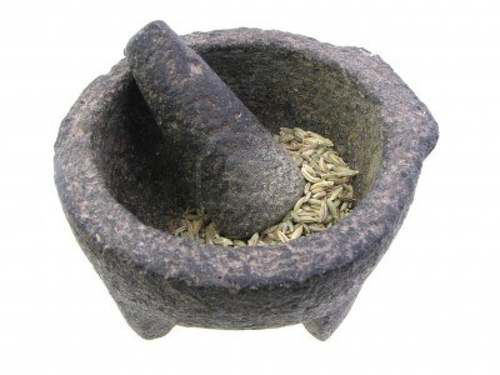
-
Schrijven met een ganzenveer
Je schreef met een ganzenveer en een potje inkt. Als de veerpunt
bot was, sneed je een nieuw puntje. Daarna eerst op een kladje even
proberen of hij weer goed schrijft. Wat schrijf je dan? Het eerste
dat je te binnen schiet; een liefdesliedje dat net in je hoofd zit
bijvoorbeeld.
Op deze onafgemaakte bladzij kun je goed zien hoe er in
het scriptorium gewerkt werd. De schrijver heeft met zwarte inkt de
gewone tekst opgeschreven. Je kunt zelfs precies zien wanneer hij
zijn pen weer in de inktpot moest dopen: steeds worden de letters
wat lichter, en daarna zijn ze weer even donker.
Bovenaan de bladzij heeft hij ruimte opengelaten voor een mooi
versierde hoofdletter C en voor de hoofdstuktitel die nog in rode
letters geschreven moest worden. En aan de randen van de bladzijde
is veel ruimte gelaten voor allerlei randversieringen en misschien
wel grappige dieren en poppetjes.
Die hoofdletter, de hoofdstuktitel en de versieringen zouden door
een ander getekend moeten worden. Maar dat is hier niet gebeurd. Is
de tekenaar misschien ziek geworden en gestorven? We weten het
niet.
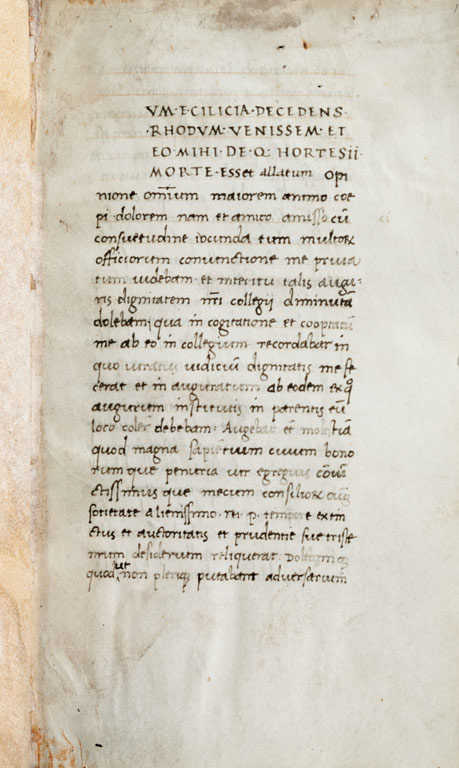
-
Prachtige versieringen
Middeleeuwse boeken werden, nadat de zwarte letters netjes
overgeschreven waren, vaak prachtig versierd. De hoofdstuktitels
werden in rode letters toegevoegd. En de eerste hoofdletter van een
hoofdstuk werd vaak heel groot en mooi getekend. En ook werden er
in de kantlijn allerlei grappige tekeningen gemaakt.
De tekenaar van dit boek heeft deze mooie hoofdletter getekend.
Zie je welke letter het is? In de letter heeft hij bovendien
zichzelf afgebeeld, terwijl hij de letter aan het tekenen is!
In de gaten van het tafeltje links van hem zijn vier
koeienhorens met gekleurde verf gestoken. En onder zijn kwast houdt
hij een bakje om de vallende verfspetters op te vangen.
Aan de kale plek bovenop zijn hoofd, de tonsuur, kun je
zien dat hij een monnik is. Boven zijn hoofd heeft hij zijn naam
geschreven: broeder Rufillus.
Op deze manier zijn heel veel Middeleeuwse boeken prachtig
versierd. In veel tekeningen is zelfs bladgoud gebruikt. Kun je
nagaan hoe duur die boeken waren!
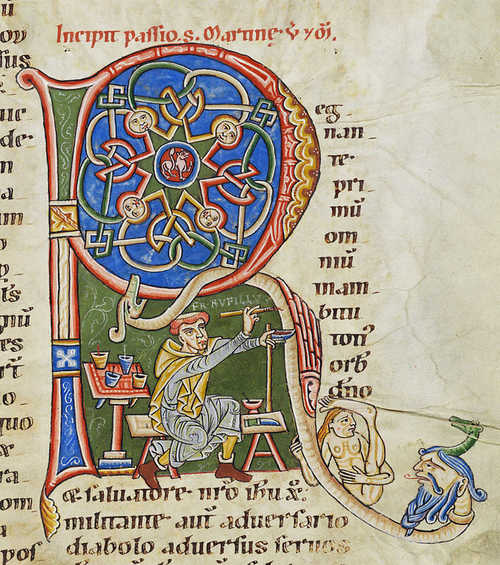
-
Zo duur als een huis
Handgeschreven boeken waren heel kostbaar. Dat kwam vooral omdat
het perkament en de kleurstoffen zo duur waren. Een mooi versierde
bijbel was rond 1270 bijvoorbeeld net zoveel waard als een groot
stenen huis.
Geen wonder dat de monniken heel zuinig waren op hun boeken.
Soms werden ze zelfs aan een ketting gelegd.
Ook kom je in een boek wel eens een ernstige waarschuwing
tegen:
Wie dit boek steelt: dat hij verlamt en dat al zijn
ledematen verdorren; dat hij wegkwijnt van pijnen en roept om
medelijden.
En dat er geen einde komt aan zijn folteringen, totdat hij
sterft. Laat boekenwormen knagen aan zijn ingewanden.
En wanneer hij uiteindelijk naar zijn laatste bestraffing
gaat, laat het vuur in de hel hem dan voor altijd doen
branden.
Dat boek laat je als dief dus maar liever liggen...
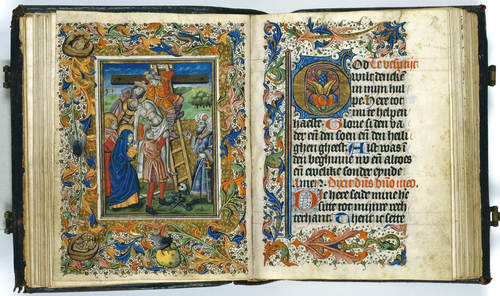
Vensterplaat Hebban olla vogala. Voor docenten: Vensterles groep 5-8. Illustratie: Wim Euverman.
